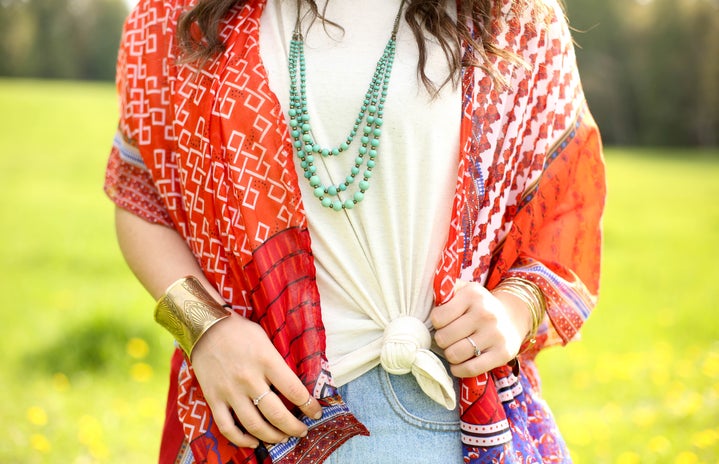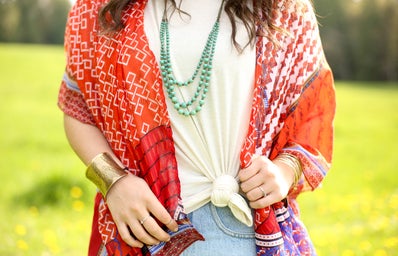If your top Pinterest search is fashion and you keep watching GRWM reels on Instagram, you‘ve most probably come across pictures and videos that act as a guide to imbibe what is called Bohemian-chic look. An oversized Kurta of vibrant colors with wide-legged jeans, loosely tied braids and some junk jewelry and a pair of ‘juttis’, is all that you need for that Boho look.
Boho fashion, short for Bohemian fashion, is a style that has its roots in the 1960s and 1970s. It is characterized by a free-spirited and non-conformist approach to dressing, featuring flowing fabrics, natural materials, and eclectic patterns. Bohemian fashion began on the streets of Paris that has its roots in the French Revolution. French society then struggled with huge economic crises, where the artists were pushed to the periphery. Even as the economy battled to recover, artists continued to express their creativity in unique and beautiful ways through apparel. The general public immediately connected this new group of artists to the itinerant gypsies who had their origins in the Balkan region of Eastern Europe, in a region known as “Bohemia,” because of their distinctive clothing. The term “Bohemian” was initially used in a derogatory way by French society to refer to the ethnic Romani population. But, over time, the name “bohemian” grew to be synonymous with a counter-culture, known for its unconventional fashion sense, free-spirited artistic expression, and contempt for societal conventions.
In recent years, the trend has seen a resurgence in popularity in India, particularly among young people. The boho style that we see today, blends the vintage components of hippie culture and bohemian dress and modifies them for a more modern appearance. Hence, while combining contemporary urban aspects, boho fashion maintains its laid-back and traditional character. What was earlier considered away from mainstream, Bohemian chic has become a global phenomena. Over the years, Boho fashion has gained a strong foothold in India, and today, India is considered as one of the centers of Boho fashion.
There are several reasons why India has become the center of Boho fashion. Firstly, India is a country with a rich cultural heritage, which has been a source of inspiration for many Boho fashion designers. The country’s colorful textiles, intricate embroidery, and traditional patterns have been incorporated into Boho fashion, creating a unique fusion of cultures. Boho fashion designers in India often draw inspiration from Indian fabrics like cotton, silk, and khadi, which are light, breathable, and comfortable to wear, making them perfect for the Boho style.
Boho fashion has become increasingly popular in the global fashion industry, with many high-profile designers incorporating bohemian elements into their collections. This has helped to popularize the trend among Indian consumers, who are often influenced by international fashion trends. The rise of social media has also helped to promote Boho fashion in India. Platforms like Instagram and Facebook have made it easier for Boho fashion designers to showcase their designs to a global audience, helping to spread the Boho fashion trend beyond India’s borders. Additionally, social media influencers and bloggers have played a significant role in promoting Boho fashion, often featuring Boho-inspired outfits in their posts. In terms of specific trends within the bohemian fashion movement, there are several key elements that have become popular in India. One of these is the use of traditional textiles and prints, such as block prints, ikat, and bandhani. These fabrics are often used in flowing, loose-fitting garments like maxi dresses and skirts. Accessories are also an important part of the boho fashion look. You can always find a variety of accessories like banjara belts, juttis and many more such items on the streets of Delhi, in few markets like Janpath and Delhi Haat. Many people in India opt for handcrafted jewelry and bags made from natural materials like leather and jute. These pieces often feature intricate embroidery or beading, adding to the overall bohemian feel.
In conclusion, India’s rich cultural heritage, diverse lifestyle, growing fashion industry, and the rise of social media have all contributed to making India a center of Boho fashion. Boho fashion designers in India continue to draw inspiration from the country’s culture and traditions, creating unique designs that are loved by people across the world. With the Boho fashion trend showing no signs of slowing down, it is safe to say that India will continue to be at the forefront of this trend for years to come.


